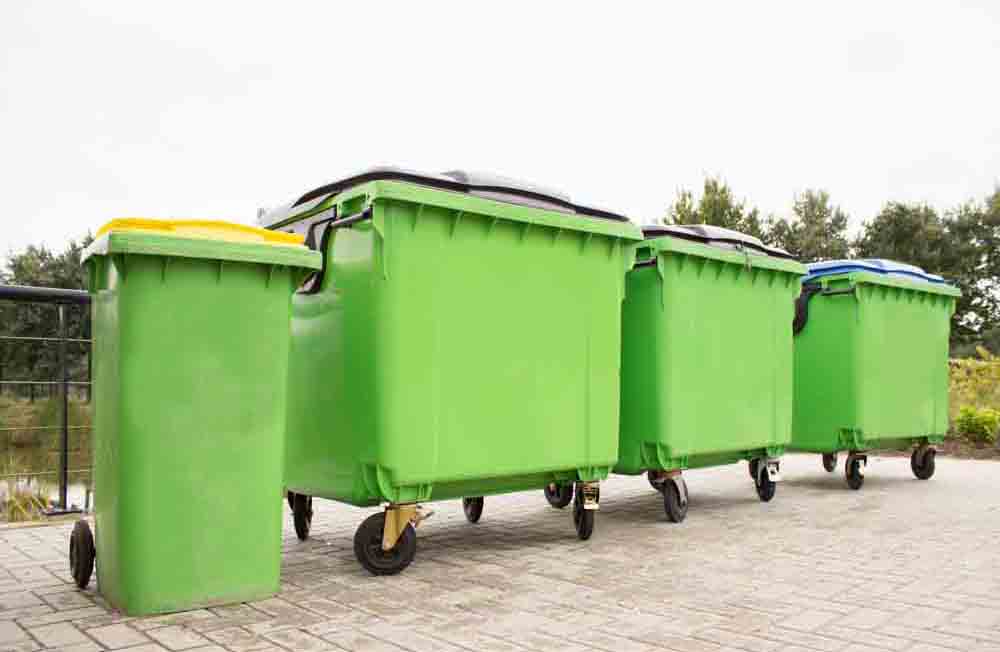A food waste panel debate at the Scottish Resources Conference in early October emphasised the need for a systems approach to tackling the issue. Envirotec reports.

AUTUMN saw the announcement of several seemingly ambitious food waste reduction targets, from the UN, the US government, and from retail groups. Scotland also announced it would soon set a public target. And France was in the media for new laws that appeared to compel supermarkets to redistribute waste food to the poor (though there was less substance to this than appeared, as it turned out). Are these measures enough? Are they meaningful? Why are we still sending so much food to landfill? How can we reduce the impact of the food production system? (Which is said to produce around a third of greenhouse gases). These and other issues were tackled by an expert panel at the Scottish Resources Conference in Glasgow in October. This comprised campaigners, innovators and entrepreneurs in the field of food waste, who seemed to largely agree on the most important steps to be taken.
One message was emphasised at the outset: The UK has made great progress, with the 21% reduction in food waste in UK households between 2007 and 2012 (as reported in 2013), being – in food waste campaigner Tristram Stuart’s view – “the most successful environmental initiative I can think of, internationally”, in terms of public mass participation. There are few parameters of environmental footprint where mass participation is making an impact, he said – most trends are going in the opposite direction. “This indicates that the people have given a mandate,” he said, “that they’ve shown that this is something they can and want to do something about.” He believed it should be a strong signal to governments, and businesses.
One of the assembled experts, Richard Swannell, director of sustainable food systems with WRAP, said he believed the UK had taken a step forward on this, with Scotland in particular leading the agenda. “Changing the behaviour of a whole nation is a big deal,” he said. Such progress was down to successful collaboration, between local authorities, groups like Zero Waste Scotland, the Scottish Government, and businesses (through initiatives like the Courtauld Commitment). “But there’s still a hell of a lot to do.” The most important thing now – echoing comments made in an opening presentation by Stuart – was to take a systems approach, thinking about the issue “from farm to fork”, not only with respect to food waste but also carbon emissions and water security.
Ode to a haggis
Stuart sounded a note of celebration about haggis in a presentation which preceded the debate. His suggestion that Scotland “remains an isolated bastion” in the consumption of offal – which has halved in the UK in the last 30 years – received a chuckle from the audience but also illustrated the wider potential to take a “nose to tail” approach throughout the food and drink supply chain, minimising waste. “If we only focus on what’s coming out of households, we’re going to miss some of the big opportunities in our extended supply chains, and really miss out on some of our global responsibilities.”
He shared one of the “big wins” of his own organisation, FeedBack, in its work with the agricultural supply chain, with farmers in Kenya growing trimmed beans. UK supermarkets had insisted on the beans being cut to fit packets 9cm wide. This meant the beans were being trimmed twice, losing 20% on average. FeedBack took the evidence to UK supermarkets, and embarked on a series of public events to raise awareness, involving recovered food – one in Brussels, for instance, incorporated some of the beans in question. Within months, he said, the supermarkets had changed their requirements from topping and tailing beans to just topping them, and had also changed their packaging to be more flexible about lengths.
For one of the Kenyan producers – who he met – this amounted to a 30% reduction in waste overnight, he said. This meant the beans saved from the scrap (compost?) heap had an equivalent value to her of 70k Euros per year.
“Think of the resource efficiencies that could be achieved if we said we were going to systematically address food waste?” It was a question that seemed to animate much of the debate which followed.
The question of targets
One thing about food waste targets: They really need to consider the whole food production system, not just the food that goes to landfill. “If we don’t include the whole supply chain in our targets, our ambitions, then we’re really missing a trick”, said Stuart. The Consumer Goods Forum seemingly set its sights high with the announcement in June of a commitment to halving food waste by 2025, though as it turned out weeks later, this only referred to food waste to landfill, not a meaningful target as far as the panel was concerned.
In mid-September the US government announced a 50% food waste reduction target, with a target date of 2030. Scotland appeared to follow when, earlier in the session, environment secretary Richard Lochead made a speech and declared an intention to introduce a formal food waste target for Scotland – a first for a European country. While the US target is not legally binding, said Stuart – “or in any way binding” – it does apply to both the amount of food actually wasted, as well as that going to landfill. Later in the debate Stuart felt the US target was somewhat handicapped by the country’s lack of data on food waste. Scotland, on the other hand, has the data to make its target more meaningful. “It will also mean more if it’s binding, as opposed to just conjectural”, following the mechanism of things like The Climate Act.
At what level should targets be set? Stuart felt the obvious one was to support the one within the UN’s Sustainable Development Goals, which calls for the world to cut per capita food waste by half by 2030. “THAT would be something.”
One problem with targets and public announcements like this is the scope for “greenwashing”. For a big food corporation to focus its PR message on food waste exclusively around household food waste “is disingenuous”, said Stuart. “It should be matched by public commitment, publicly reported figures on their own food waste and their commitment to reduce that.”

Data deficit
You can’t do anything meaningful without transparent reporting on food waste, an area where the behaviour of the big food businesses was currently “totally unacceptable”, he said. The aggregate figures for the sector are available – progress, at least – but with the exception of Tesco, none of them have begun to report individually how much food they waste. He also sounded a sceptical note about AD: “Just saying ‘we’re going to divert all our food waste to AD’ has been the biggest get-out clause since food waste was invented… AD is only slightly less environmentally damaging than sending it to landfill – let’s be honest about that.” It discounts impacts from the supply chain, impacts on biodiversity and all the other factors involved in producing the food.
Lindsay Boswell, chief executive of FareShare, another panel member, appeared to agree, but sounded a protective note about AD. It was “one of the biggest threats to the AD industry”, in Boswell’s view, this tendency to accuse it of allowing food to be wasted while others go hungry. “We’re one of the leading nations for AD, and we need to protect that.” Swannell appeared to agree: “AD is renewable energy, it does put fertiliser back on the land, and it is about generating a more circular economy… I’d rather not dismiss it, as there is unavoidable food waste [ that has to be dealt with ].”
Consumer expectations
But clearly the retailers aren’t showing enough leadership on this issue, and while one panellist said they were just doing their job of satisfying consumers, the chair Sally Magnusson asked: “Who sets the expectation?” Boswell said that, as consumers, we don’t seem to care enough about this. “But if we can talk to each other as citizens, that’s where you start to shift those expectations,” he said. Swannel felt one reason it wasn’t high on our agenda as consumers was that most of us don’t believe we waste food, even now. When WRAP did a survey in 2007 only 10% of consumers believed they wasted food – that has since changed a bit but it’s still only 30%. So “engaging with the point in the first place” remains a key challenge.
Another panel member, Grant Keenan, director of Keenan Recycling, added that food waste collection – where it exists – has changed behaviour. “After filling multiple caddies [ they’ve ] realised that they do [ have food waste ], and have changed their habits accordingly.”
Maybe the cost of food is part of it. Rich countries only spend around 10% of their income on food, and these are the places where so much is wasted. The answer wasn’t to increase prices, Stuart felt – which hits the poorest hardest – but to get more leverage via peer pressure and communication. Evidence supporting this strategy comes from a WRAP econometric study in the UK, looking at how to attribute food waste reduction in households. The recession and spending constraints was clearly a factor but, he said, at least 40% of the reduction we’ve seen appears to be down to awareness raising and “getting the message across that this is something people ought to be doing”
Magnusson at another stage cited the hotel sector’s actions with towels in hotel bathrooms – that you don’t know what you want as a consumer till it’s in front of you. The hotel sector took responsibility for this issue – food businesses have that power and maybe they should start using it to communicate to people why they should change their behaviour. One of the panel, Alan Hayes, strategy and environment manager with The Institute of Grocery and Distribution, said he had been working with WRAP for a couple of years on a programme called “Working On Waste”, which has involved getting companies from across the agriculture and food industry “to talk to their employees in their capacity as citizens and shoppers”, bringing messages from the “Love Food, Hate Waste” campaign into the workplace, “in a way that enables them to go and do something different”.
Progress with redistribution
There has been a noticeably greater interest in redistributing food of late. Earlier in the session Stuart mentioned the recent publicity around a law change in France. Unfortunately it was only about the food waste arising from the back of stores, so “only a small percentage of the food waste supermarkets actually cause”. It also wasn’t as binding as everyone had assumed. “It doesn’t actually make them give it to charities, it just makes them have a relationship with them… And in any case the law has been annulled by the constitutional council so it [ now ] doesn’t exist.”
In the UK, Hayes shared details of a programme his organisation has just finished piloting with Tesco, called Fare Share Food Plan, which connects local charities with local stores, to redistribute food – the intention being to have them all connected in this way by the end of 2016. What started as a PR exercise has now taken off, he said, with hugely positive feedback from Tesco staff. The plan is to roll out this scheme with other supermarkets, to get the whole of the retail sector working with the voluntary sector in this way. Stuart believed staff morale could benefit hugely from schemes to avoid unnecessary food waste in this way.

Anatomy of a bin
Keenan felt the need for action was clearly obvious “now that we can actually see what’s being pulled out of the waste stream in terms of supermarket waste.” His own firm does a lot of work with supermarkets, he said. When they bring the bins back to their facility, it’s “horrific when you see what’s in it… Lots of the food is still in date, there’s nothing wrong with it.”
An audience member asked why is so much waste still being allowed to go to landfill? Keenan said there is a huge push to stop that happening, citing the Scottish government’s regulations on separating food waste, with another organic ban to landfill scheduled for 2020. However, he also said he felt that “the waste management sector has dragged its heels in recent years over getting alive to what is actually in the bins”. When his firm started out they worked in partnership with waste management firms. “I was baffled as to how a waste management company could charge say £12 or 13 for a bin that could have half a ton of food waste in it” – with landfill tax being as high as it is and tipping fees being over 100 pounds. Why are they simply losing money on these bins? He got the answer from a salesman who told him ‘it’s all about KPIs’. The salesmen are incentivised by the waste management companies to get as many wheelie bins into the market as they possibly can. And nobody was sitting down looking at what was actually in them. They simply took the view that some will be good, some will be bad – it’ll all even out in the end.
Restaurant reporting
The restaurant sector also has room for initiative. Swannell gave the example of Crieff Hydro, a hotel in Scotland with several restaurants on site, which recently began to measure food waste. “When they did, they realised they were getting wastage rates of 30% to 40%. And as soon as they found that they thought ‘crikey! We can do something about this!’” The result has been savings of around £50k per year. An audience member wondered how we as consumers might know if a hotel is doing this kind of thing. Swannel said some companies have started to include in their communications and signage things like “we are a food waste-free restaurant”. But often the customer response has not been massively positive.
Guidance for restaurants on minimising food waste is available on WRAP’s website in the shape of its “Hospitality and Food Services Agreement”.
Crunching the numbers
The financial pay-off for the hospitality sector is now obvious, said Stuart, citing the recent success of a firm, Winnow Solutions, which provides a “digital food waste management tool”. Staff chuck food into a special bin and “spend a split-second” making an electronic record of what they’ve put in. This provides a really granular dataset for the food ordering manager or chef to work with. In 18 months or so the firm has reportedly just saved its second million pound worth of food, and has increased profit margins for its clients by 30% in some cases. This is one of the “really big obvious financial wins” available to the food businesses, he said. Consumer waste is a much harder problem.








